Abstract
A search was made in sympathetic ganglia of the bullfrog for a noncholinergic, nonaminergic transmitter that is released by a distinct group of preganglionic axons. These initiate a late slow excitatory postsynaptic potential which lasts for many minutes. The most promising candidate for the role of transmitter is a peptide that resembles luteinizing hormone-releasing hormone (LHRH; luliberin). The reasons are: (i) LHRH (1 muM) and some of its analogs cause a slow depolarization of ganglion cells. (ii) Radioimmunoassays established that 100-800 pg of a LHRH-like substance is contained in the lumbar chain of sympathetic ganglia. (iii) The LHRH-like material is specifically distributed in those spinal nerves that contain axons that initiate the slow noncholinergic synaptic responses. (iv) Five days after ipsilateral preganglionic axons are cut, 95% of the LHRH-like substance disappears from ganglia, while the LHRH immunoreactivity triples in the spinal nerves proximal to the cut region. (v) About 0.6% of the LHRH-like material within ganglia can be collected from the perfusate after 30 min of incubation in isotonic KC1; this release is Ca dependent. (vi) The candidate for transmitter has several chemical characteristics of a peptide and has a Mr near 1000.
Full text
PDF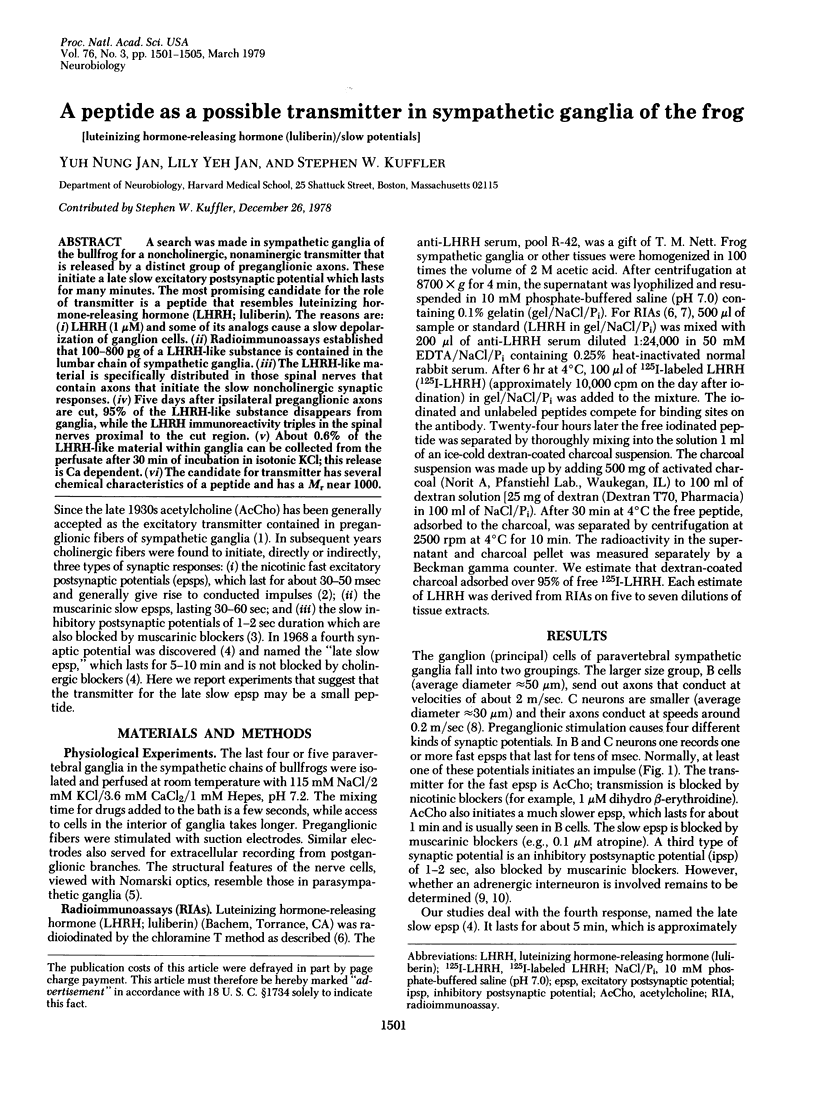
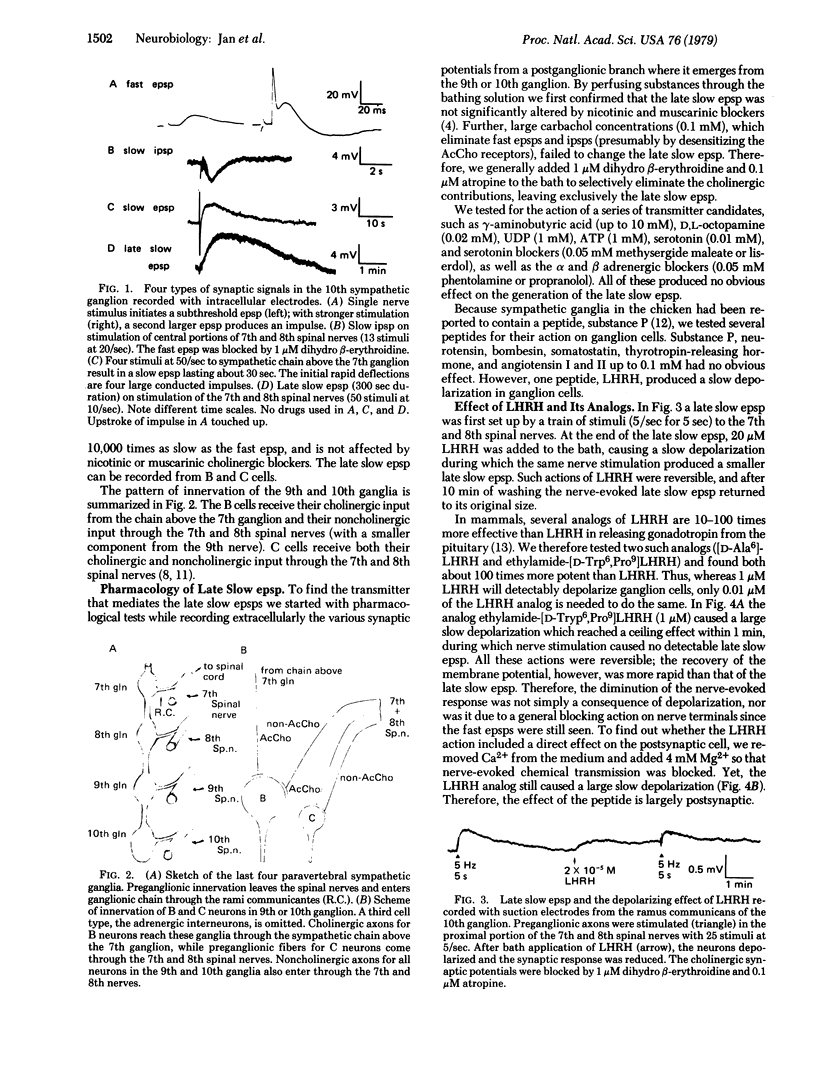
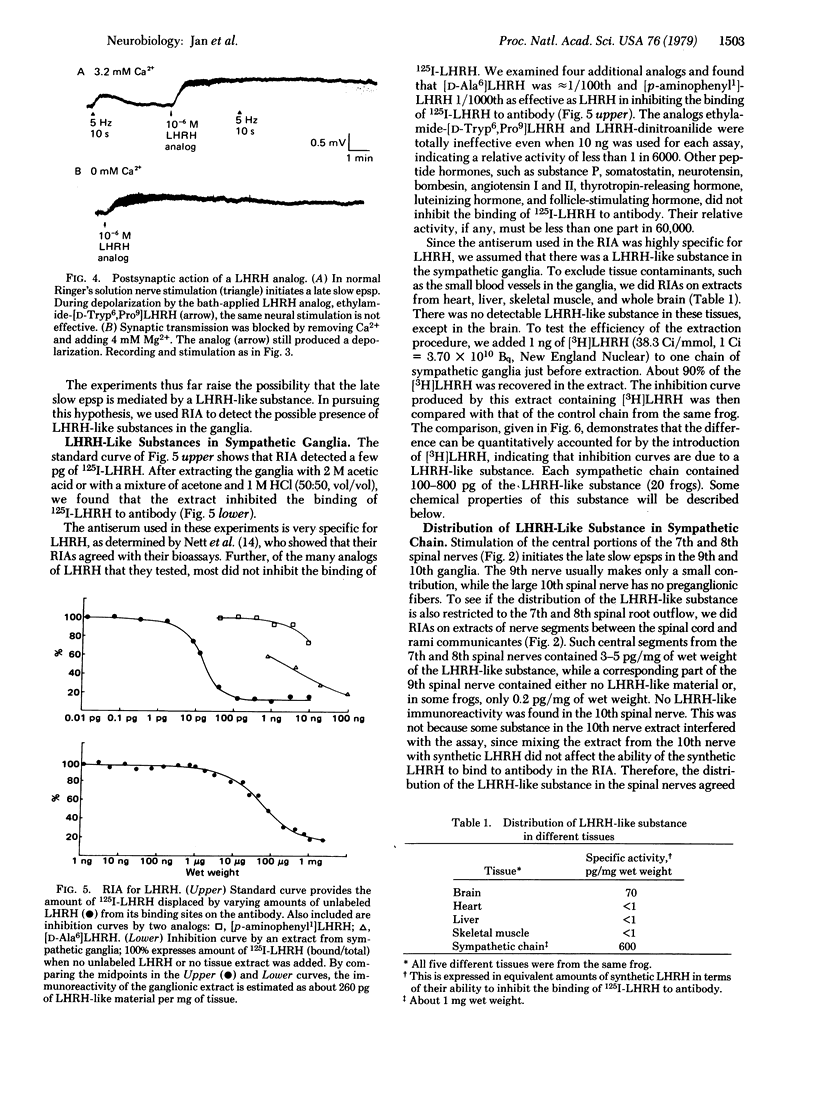
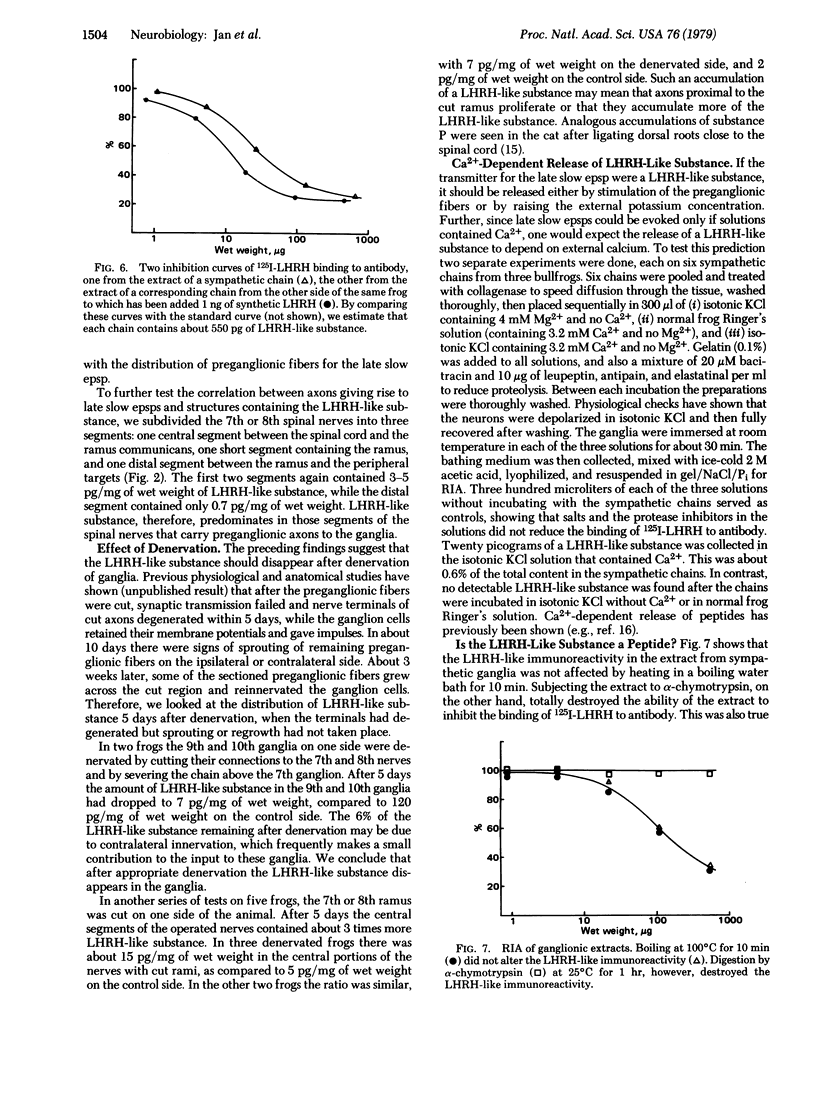
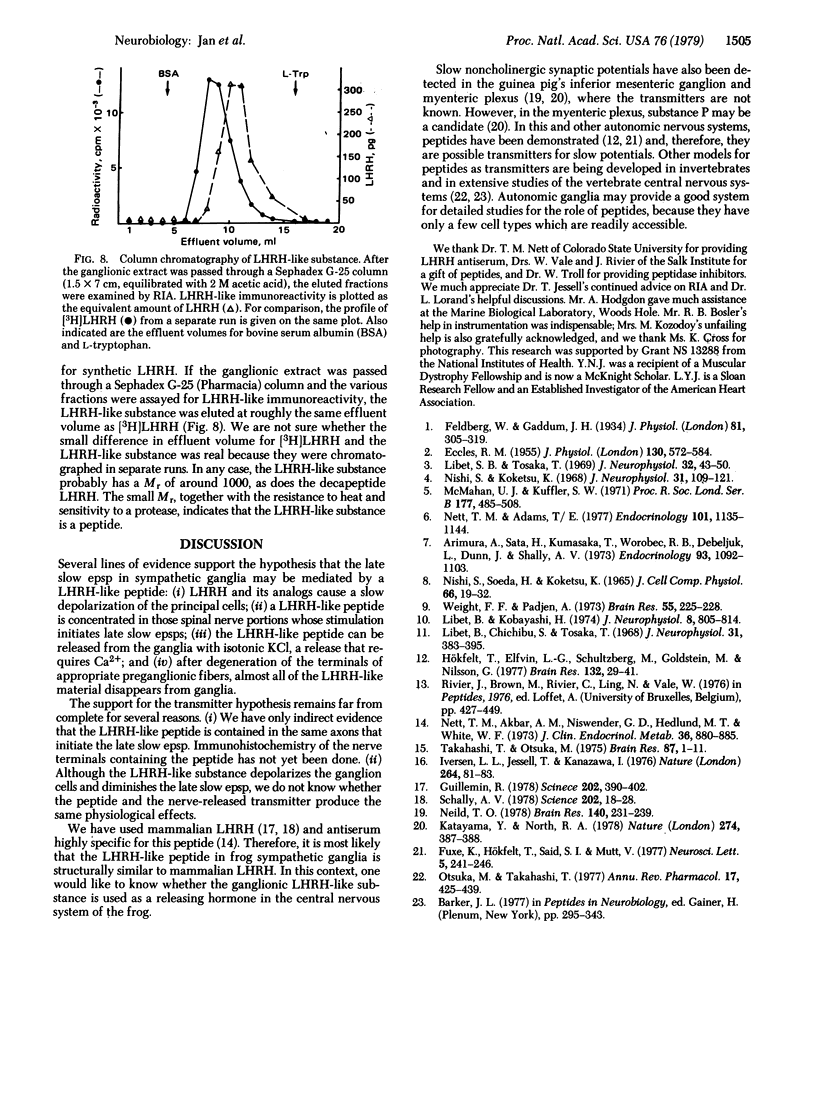
Images in this article
Selected References
These references are in PubMed. This may not be the complete list of references from this article.
- Arimura A., Sato H., Kumasaka T., Worobec R. B., Debeljuk L., Dunn J., Schally A. V. Production of antiserum to LH-releasing hormone (LH-RH) associated with gonadal atrophy in rabbits: development of radioimmunoassays for LH-RH. Endocrinology. 1973 Nov;93(5):1092–1103. doi: 10.1210/endo-93-5-1092. [DOI] [PubMed] [Google Scholar]
- ECCLES R. M. Intracellular potentials recorded from a mammalian sympathetic ganglion. J Physiol. 1955 Dec 29;130(3):572–584. doi: 10.1113/jphysiol.1955.sp005428. [DOI] [PMC free article] [PubMed] [Google Scholar]
- Feldberg W., Gaddum J. H. The chemical transmitter at synapses in a sympathetic ganglion. J Physiol. 1934 Jun 9;81(3):305–319. doi: 10.1113/jphysiol.1934.sp003137. [DOI] [PMC free article] [PubMed] [Google Scholar]
- Guillemin R. Peptides in the brain: the new endocrinology of the neuron. Science. 1978 Oct 27;202(4366):390–402. doi: 10.1126/science.212832. [DOI] [PubMed] [Google Scholar]
- Hökfelt T., Elfvin L. G., Schultzberg M., Goldstein M., Nilsson G. On the occurrence of substance P-containing fibers in sympathetic ganglia: immunohistochemical evidence. Brain Res. 1977 Aug 19;132(1):29–41. doi: 10.1016/0006-8993(77)90704-1. [DOI] [PubMed] [Google Scholar]
- Iversen L. L., Jessell T., Kanazawa I. Release and metabolism of substance P in rat hypothalamus. Nature. 1976 Nov 4;264(5581):81–83. doi: 10.1038/264081a0. [DOI] [PubMed] [Google Scholar]
- Katayama Y., North R. A. Does substance P mediate slow synaptic excitation within the myenteric plexus? Nature. 1978 Jul 27;274(5669):387–388. doi: 10.1038/274387a0. [DOI] [PubMed] [Google Scholar]
- Libet B., Chichibu S., Tosaka T. Slow synaptic responses and excitability in sympathetic ganglia of the bullfrog. J Neurophysiol. 1968 May;31(3):383–395. doi: 10.1152/jn.1968.31.3.383. [DOI] [PubMed] [Google Scholar]
- Libet B., Kobayashi H. Adrenergic mediation of slow inhibitory postsynaptic potential in sympathetic ganglia of the frog. J Neurophysiol. 1974 Jul;37(4):805–814. doi: 10.1152/jn.1974.37.4.805. [DOI] [PubMed] [Google Scholar]
- Libet B., Tosaka T. Slow inhibitory and excitatory postsynaptic responses in single cells of mammalian sympathetic ganglia. J Neurophysiol. 1969 Jan;32(1):43–50. doi: 10.1152/jn.1969.32.1.43. [DOI] [PubMed] [Google Scholar]
- McMahan U. J., Kuffler S. W. Visual identification of synaptic boutons on living ganglion cells and of varicosities in postganglionic axons in the heart of the frog. Proc R Soc Lond B Biol Sci. 1971 Apr 27;177(1049):485–508. doi: 10.1098/rspb.1971.0044. [DOI] [PubMed] [Google Scholar]
- Neild T. O. Slowly-developing depolarization of neurones in the guinea-pig inferior mesenteric ganglion following repetitive stimulation of the preganglionic nerves. Brain Res. 1978 Jan 27;140(2):231–239. doi: 10.1016/0006-8993(78)90457-2. [DOI] [PubMed] [Google Scholar]
- Nett T. M., Adams T. E. Further studies on the radioimmunoassay of gonadotropin-releasing hormone: effect of radioiodination, antiserum and unextracted serum on levels of immunoreactivity in serum. Endocrinology. 1977 Oct;101(4):1135–1144. doi: 10.1210/endo-101-4-1135. [DOI] [PubMed] [Google Scholar]
- Nett T. M., Akbar A. M., Niswender G. D., Hedlund M. T., White W. F. A radioimmunoassay for gonadotropin-releasing hormone (Gn-RH) in serum. J Clin Endocrinol Metab. 1973 May;36(5):880–885. doi: 10.1210/jcem-36-5-880. [DOI] [PubMed] [Google Scholar]
- Nishi S., Koketsu K. Early and late after discharges of amphibian sympathetic ganglion cells. J Neurophysiol. 1968 Jan;31(1):109–121. doi: 10.1152/jn.1968.31.1.109. [DOI] [PubMed] [Google Scholar]
- Nishi S., Soeda H., Koketsu K. Studies on sympathetic B and C neurons and patterns of pregnaglionic innervation. J Cell Physiol. 1965 Aug;66(1):19–32. doi: 10.1002/jcp.1030660103. [DOI] [PubMed] [Google Scholar]
- Otsuka M., Takahashi T. Putative peptide neurotransmitters. Annu Rev Pharmacol Toxicol. 1977;17:425–439. doi: 10.1146/annurev.pa.17.040177.002233. [DOI] [PubMed] [Google Scholar]
- Schally A. V. Aspects of hypothalamic regulation of the pituitary gland. Science. 1978 Oct 6;202(4363):18–28. doi: 10.1126/science.99816. [DOI] [PubMed] [Google Scholar]
- Takahashi T., Otsuka M. Regional distribution of substance P in the spinal cord and nerve roots of the cat and the effect of dorsal root section. Brain Res. 1975 Apr 4;87(1):1–11. doi: 10.1016/0006-8993(75)90774-x. [DOI] [PubMed] [Google Scholar]
- Weight F. F., Padjen A. Acetylcholine and slow synaptic inhibition in frog sympathetic ganglion cells. Brain Res. 1973 May 30;55(1):225–228. doi: 10.1016/0006-8993(73)90506-4. [DOI] [PubMed] [Google Scholar]



